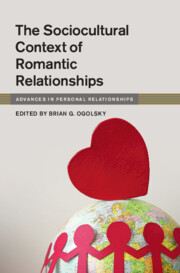Book contents
- The Sociocultural Context of Romantic Relationships
- Advances in Personal Relationships
- The Sociocultural Context of Romantic Relationships
- Copyright page
- Contents
- Contributors
- 1 The Sociocultural Context of Romantic Relationships
- 2 Systemic Racism and Romantic Relationships
- 3 Sociocultural Perspectives on Romantic Relationships
- 4 Gender and Heteronormativity in Romantic Relationships
- 5 Social Class, Neighborhoods, and Romantic Relationships
- 6 Religion and Spirituality in Romantic Relationships
- 7 The Importance of Work in Romantic Relationships
- 8 History and Cohort Effects in Romantic Relationships
- 9 The Legal Meaning of Sex (and Romantic Relationships)
- 10 Romantic Relationships and Traditional Media
- 11 Romantic Relationships and Social Media
- 12 Situating Latinx Immigrant Romantic Relationships in the Context of Illegality
- 13 Romantic Relationships during a Global Pandemic
- Index
- References
5 - Social Class, Neighborhoods, and Romantic Relationships
Published online by Cambridge University Press: 19 October 2023
- The Sociocultural Context of Romantic Relationships
- Advances in Personal Relationships
- The Sociocultural Context of Romantic Relationships
- Copyright page
- Contents
- Contributors
- 1 The Sociocultural Context of Romantic Relationships
- 2 Systemic Racism and Romantic Relationships
- 3 Sociocultural Perspectives on Romantic Relationships
- 4 Gender and Heteronormativity in Romantic Relationships
- 5 Social Class, Neighborhoods, and Romantic Relationships
- 6 Religion and Spirituality in Romantic Relationships
- 7 The Importance of Work in Romantic Relationships
- 8 History and Cohort Effects in Romantic Relationships
- 9 The Legal Meaning of Sex (and Romantic Relationships)
- 10 Romantic Relationships and Traditional Media
- 11 Romantic Relationships and Social Media
- 12 Situating Latinx Immigrant Romantic Relationships in the Context of Illegality
- 13 Romantic Relationships during a Global Pandemic
- Index
- References
Summary
Falling in love is free…or is it? Although our “heart” and emotions may be unconnected to how much money or education we have or where we live, the process of initiating and maintaining a romantic relationship is most definitely connected to socioeconomic status (SES) and place. This chapter reviews the literature from the past fifteen years on the role of social class in four stages of romantic relationships: dating, cohabitation, marriage, and divorce. The existing research reveals several patterns. First, social class impacts all stages of a relationship, which contributes to perpetuating social class inequities throughout generations. Second, heteronormative assumptions dominate the existing literature with little focus on LGBTQ+ relationships. Moreover, gender appears to overshadow any impact of social class – in other words, women and men are bound by gender role expectations in relationships regardless of SES. Finally, and most importantly, research shows that most individuals, regardless of social class, hope to find a life partner and start a family. What social class “buys” an individual in terms of romance is ease…ease to date, marry, and divorce.
- Type
- Chapter
- Information
- The Sociocultural Context of Romantic Relationships , pp. 71 - 89Publisher: Cambridge University PressPrint publication year: 2023



